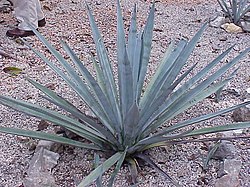Agave syrup
From Wikipedia, the free encyclopedia

Agave tequilana Blue Agave
Agave syrup (also called agave nectar) is a sweetener commercially produced in Mexico, from several species of agave, including Agave tequilana (also called Blue Agave or Tequila Agave), and the Salmiana, Green, Grey, Thorny, and Rainbow varieties.[1] Agave syrup is sweeter than honey, though less viscous.
Agave syrup is produced in the Mexican States of Jalisco, Michoacán, Guanajuato and Tamaulipas, according to Mexican laws pertaining to certificate of origin, although most is produced in Jalisco.
Production
To produce agave nectar, juice is expressed from the core of the agave, called the piña.[1] The juice is filtered, then heated, to hydrolyze carbohydrates into sugars. The main carbohydrate is a complex form of fructose called inulin or fructosan. The filtered, hydrolyzed juice is concentrated to a syrup-like liquid a little thinner than honey and ranges in color from light to dark depending on the degree of processing. The syrup naturally contains quantities of iron, calcium, [[potassium] & magnesium which contribute to the resulting color.[citation needed]
An alternative method used to process the agave juice without heat is described in a United States patent for a process that uses enzymes to hydrolyze the polyfructose extract into fructose, using an enzyme derived from Aspergillus niger (black mold). [2] A. niger fermentation is "generally regarded as safe" (GRAS) by the FDA.[3]
Composition
Agave syrup consists primarily of fructose and glucose. One source[4] gives 92% fructose and 8% glucose; another[5] gives 56% fructose and 20% glucose. These differences presumably reflect variation from one vendor of agave syrup to another. Due to its fructose content and the fact that the glycemic index only measures glucose levels, agave syrup is notable in that its glycemic index and glycemic load are lower than many other natural sweeteners on the market. [6].
However, the extremely high percentage of fructose (higher than that of high-fructose corn syrup) can be deleterious and can trigger fructose malabsorption, metabolic syndrome[7], hypertriglyceridemia, decreased glucose tolerance, hyperinsulinemia, and accelerated uric acid formation.[8][9][10] Low-carb diet advocate Dr. Michael Eades M.D. advises to "avoid it [Agave syrup] like death".[11]
Some criticism [12] has targeted agave syrup. In the late 1990s, the agave syrup on the market contained 90% thermally or chemically hydrolyzed fructose, the salmiana variety syrup on the market today is still primarily fructose, but is enzymatically hydrolyzed using a black mold enzyme.
Read more about Agave Nectar CLICK HERE





